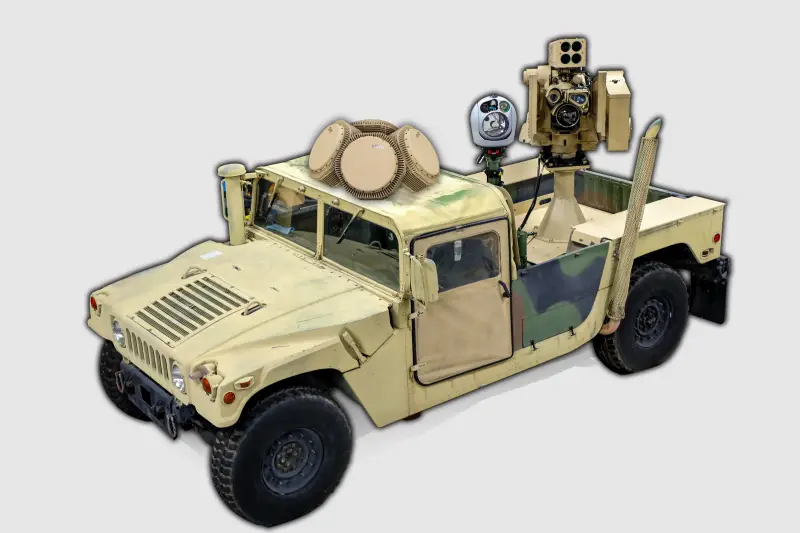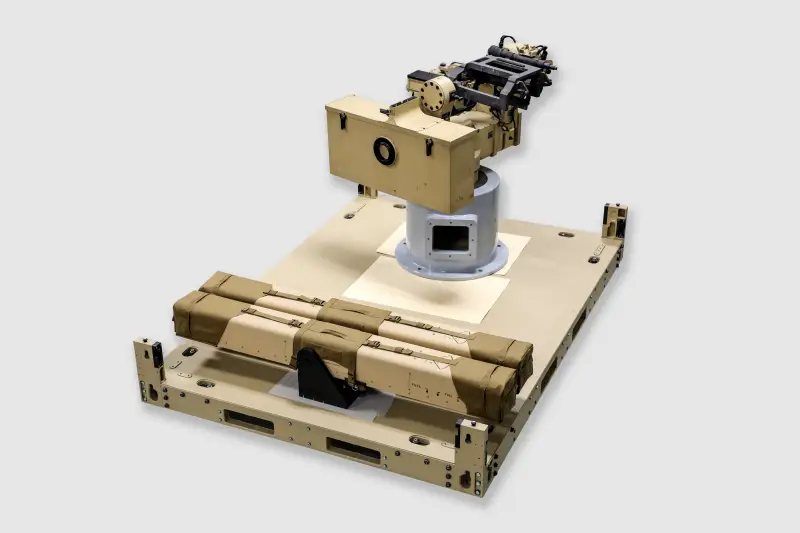The Pentagon ordered the EAGLS C-UAS air defense system with APKWS II missiles

Mobile version of the EAGLS C-UAS air defense system. MSI DS Graphics
The US Navy, like other Pentagon structures, is paying increased attention to issues of countering and combating unmanned aerial vehicles. The next step in this direction was recently a contract for the supply of promising EAGLS C-UAS air defense systems developed by MSI Defense Solutions. Due to the special importance of this area, the order begins immediately and the first finished products are expected in the coming weeks.
Urgent solution
Several years ago, BAE Systems introduced the Advanced Precision Kill Weapon System (APKWS) project. It provided for equipping an uncontrolled aviation Hydra 70 missiles with a special guidance unit that turns it controlled weapon. Subsequently, they introduced the modernized APKWS II kit.
The modified Hydra-70 missile launchers were proposed to be used to solve various fire missions, incl. to combat small-sized UAVs. Soon the first projects of anti-aircraft systems based on the APKWS guided missile appeared. One of them was presented last year by MSI Defense Solutions from Mooresville (North Carolina). This project is called EAGLS C-UAS (Electronic Advanced Ground Launcher System Counter UAS - “Advanced electronic ground launcher for combating UAVs”).
For some time, the EAGLS product underwent field tests and showed its characteristics and capabilities, incl. under the supervision of Pentagon representatives. The air defense system coped with combat training tasks and received positive ratings. Moreover, he managed to fully interest the military, which recently led to the receipt of an order and the start of production.
On February 13, 2024, the Pentagon, represented by the Naval Air Systems Command (NAVAIR), issued an order to MSI DS for the production and delivery of EAGLS C-UAS products. According to the document, the contractor must manufacture and supply the fleet five new model complexes and a set of various spare parts and accessories, as well as train calculations. The total cost of the contract is $24,2 million. Accordingly, the purchase of each complex and auxiliary equipment for it cost the Pentagon $4,84 million.

Stationary version of the complex. MSI DS Graphics
Particular attention should be paid to the order completion times specified in the contract. The executing company was given only a month after the order was issued to assemble and deliver the first product of the batch. The next four air defense systems are expected within two to three months from the date of signing the contract. In other words, the lead EAGLS air defense system was supposed to be available to the Navy by mid-March, and the remaining ones by mid-May.
In a dangerous region
Information on the purchase of the EAGLES air defense system was officially published on April 12 on the corresponding resource of the US federal government. We revealed the organizational aspects of deliveries, cost, volume, etc. At the same time, some of the information from the contract is not subject to publication, and it was removed from the posted documents.
Of particular interest in the documentation is the procurement justification section. He reports that the new systems will be deployed in the area of responsibility of the Central Command of the Armed Forces (CENTCOM), but without specifying a specific region or bases. The urgency of issuing the contract and the short deadlines for its execution are due to the difficult situation in this zone. Troops subordinate to CENTCOM, while solving assigned tasks, may face various threats. The answer to them, quick and effective, should be a new air defense system.
It should be recalled exactly where US Central Command operates. Its area of responsibility includes North Africa, the Middle East and part of Central Asia, as well as nearby seas. Apparently, EAGLS C-UAS products are intended for use on Middle Eastern bases - it is in this region that there is an increased danger of UAVs, and measures to protect against them are required.
It is curious that the need to purchase new air defense systems designed to operate against unmanned aerial targets has already received the most direct confirmation. Coincidentally, April 13th, i.e. the day after the publication of the procurement documents, Iran's armed forces launched a massive attack on Israeli targets. A variety of missiles were used in this operation, as well as a number of UAV models. The air defense of Israel and friendly states showed acceptable results, but still missed some missiles and drones.

The principle of assembling the APKWS II rocket. Wikimedia Commons Graphics
Judging by the required delivery times, the first EAGLS product could have already been transferred to NAVAIR, and it cannot be ruled out that it was already sent to the Middle East. If this is so, then the air defense system could take part in repelling the Iranian attack. However, the presence of such equipment in the crisis zone has not yet been reported, as well as training or combat firing.
However, the overall situation shows that US forces in the region, as well as their allies, do need new air defense capabilities that can cope with complex targets. Five EAGLES air defense systems in the coming months will be the first response to such challenges and will have to show their potential. If the experience of their operation is positive, new orders for the same or similar systems may appear.
From available components
The EAGLS C-UAS product is a short-range air defense system designed to protect military bases, troops in positions and other important facilities. To simplify and speed up development and production, the complex is assembled from available components, and MSI DS actually acts only as an integrator and is responsible only for the final assembly of products. A similar approach is used in other American air defense systems and has received good ratings.
To illuminate the air situation, the air defense system includes a Leonardo RPS-42 MHR radar. It includes one control unit and several phased arrays, between which the upper hemisphere is distributed. The detection range of air targets, depending on their parameters, reaches 30 km. The radar can be supplemented with an EOS of the desired model.
The basis of the complex is the serial remotely controlled combat module Commonly Remotely Operated Weapon Station II (CROWS II). It has guidance drives in two planes and is equipped with an optical-electronic station with a day and night channel, as well as a laser rangefinder-target designator. The module is equipped with a mount for a transport and launch container for four APWKS II missiles.

Vampire SAM from L3Harris, also using APKWS II missiles. Photo by L3Harris
The AGR-20 APKWS II missile is an unguided Hydra 70 projectile with a WGU-59/B control and guidance unit. The latter is placed between the head warhead and the engine housing. The control unit has folding X-shaped rudders and a semi-active laser homing head. Instead of a single optical receiver in the head fairing, four smaller ones are used, mounted on the control surfaces. With all this, the guided missile retains the standard warhead and Hydra solid-fuel engine.
The total length of the APKWS II rocket reaches 1,87 m with a body diameter of 70 mm. Weight – 15 kg. By comparison, the Hydra 70 is just over 1m long and weighs up to 12kg. Guided ammunition reaches speeds of up to 900-1000 m/s. When launched from a ground installation against an air target, the flight range does not exceed 5-6 km. At the same ranges, the capture of an illuminated target is ensured.
MSI DS offers two versions of the EAGLS air defense system. The first is stationary and provides for the installation of a DBM, radar and EPS on the platform. Such a complex must be transported by a truck and placed in position using a crane. The mobile air defense system is proposed to be built on any suitable chassis, starting from the HMMWV. In this case, all air defense systems are mounted on the loading platform and/or roof of the carrier vehicle. The complex in a vehicle can move between positions, but shooting while moving is not provided.
The operating principle of the EAGLS C-UAS air defense system is quite simple. Using its own radar or EPS, the complex searches for air targets; It is also possible to work on external target designation. The detected target is tracked and illuminated by a laser, after which the missile is launched. The APKWS II product independently flies to the target and aims at it. High accuracy is declared for hitting low-flying targets with limited speed that are not performing active maneuvers.
With unknown result
Thus, the Pentagon understood how potential enemy UAVs affect the situation in the Middle East and what danger they pose to American troops. In this regard, urgent measures are being taken to create and purchase specialized air defense systems. To date, the NAVAIR command has ordered several new EAGLS C-UAS systems, and the first of them could already enter the troops.
When the new air defense systems will have to repel real attacks and what results they will be able to show is still unknown. However, the very first episodes of combat use will show the potential of both the EAGLS product and other developments based on the same components. Time will tell whether the new air defense system will meet the customer's expectations.
Information